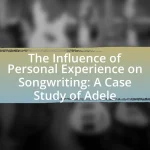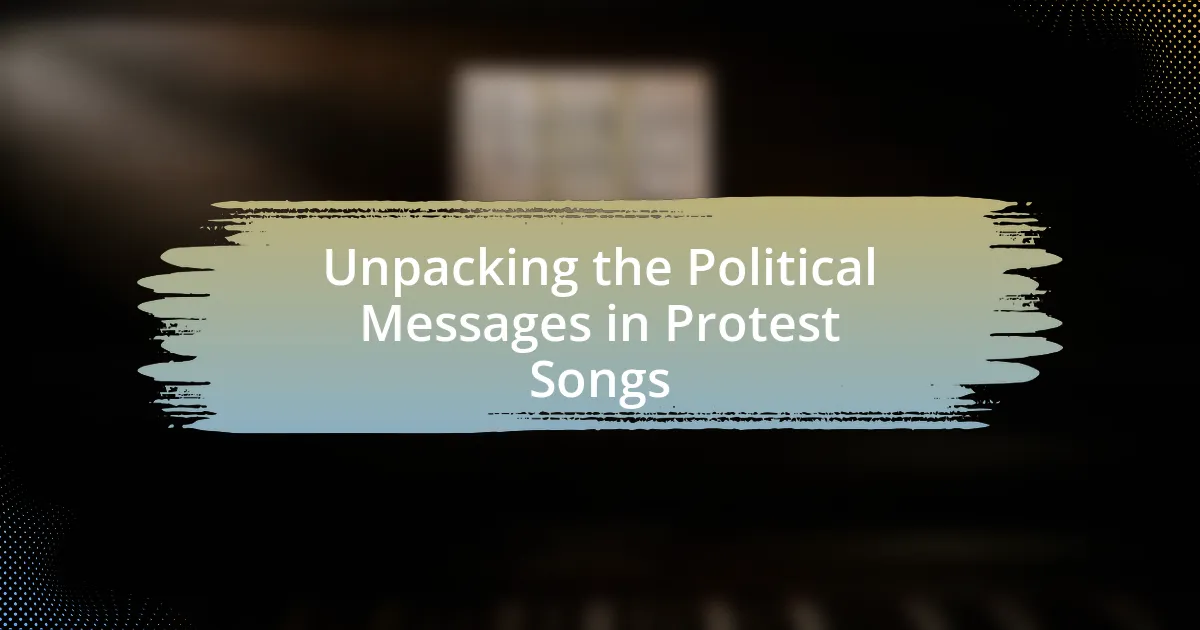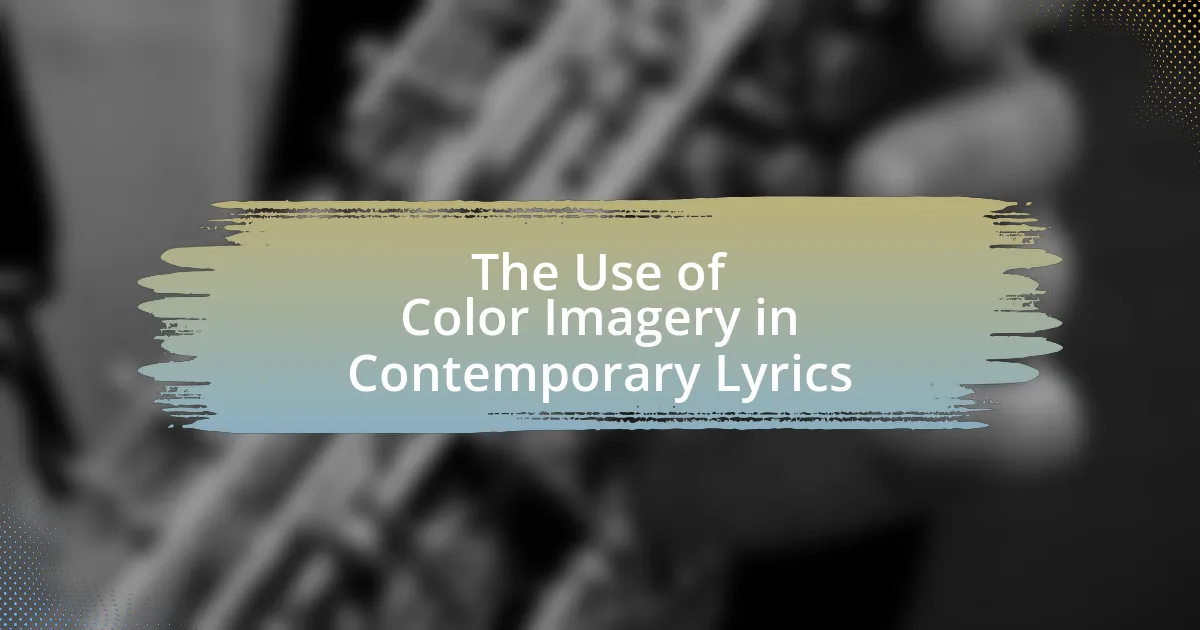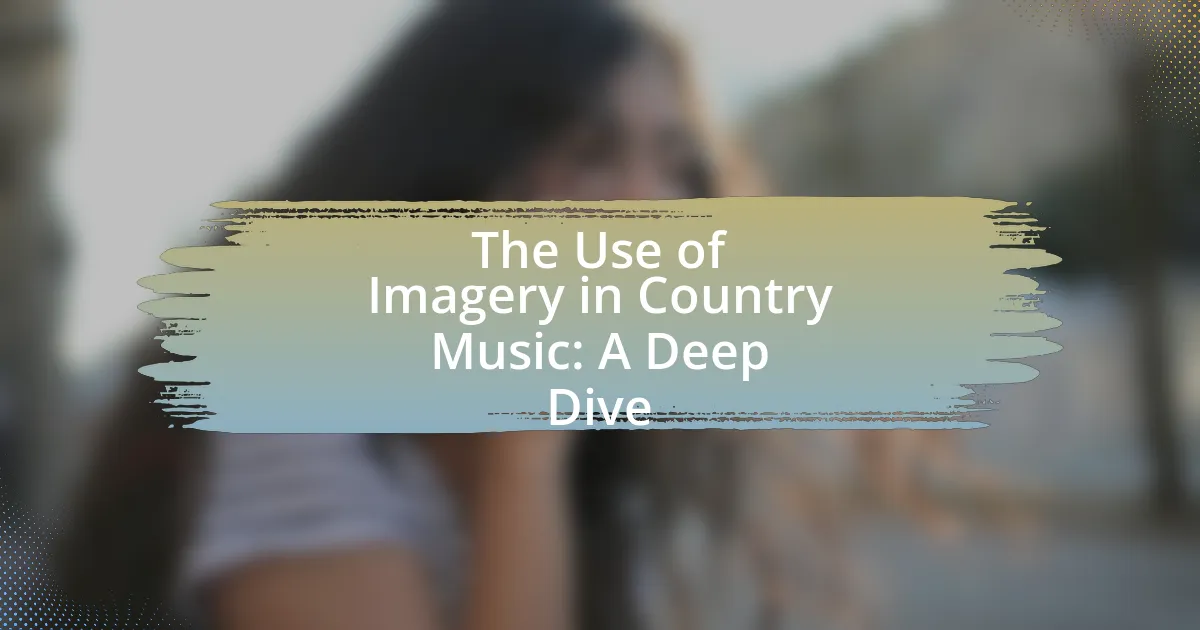The article examines the evolution of love themes in R&B lyrics, highlighting key motifs such as romantic love, heartbreak, longing, and empowerment. It traces the transformation of these themes from the 1960s, characterized by idealized romance, to contemporary expressions that include emotional vulnerability and self-love. The discussion includes the impact of cultural factors, the role of storytelling, and the influence of different R&B subgenres on the portrayal of love. Additionally, it explores how collaborations and personal narratives enhance emotional depth in R&B music, providing practical tips for artists to create compelling love lyrics.

What are the key love themes in R&B lyrics throughout history?
Key love themes in R&B lyrics throughout history include romantic love, heartbreak, longing, and empowerment. Romantic love is often expressed through passionate declarations and intimate storytelling, as seen in classics like “Let’s Stay Together” by Al Green. Heartbreak is a prevalent theme, with artists like Toni Braxton in “Un-Break My Heart” conveying deep emotional pain and loss. Longing is illustrated in songs such as “Need You Bad” by Jazmine Sullivan, where desire and yearning are central. Empowerment, particularly in the context of self-love and independence, is highlighted in tracks like “Survivor” by Destiny’s Child, showcasing resilience in the face of relationship challenges. These themes reflect the emotional depth and complexity of love, resonating with listeners across generations.
How have love themes evolved from the 1960s to the present?
Love themes in R&B lyrics have evolved significantly from the 1960s to the present, transitioning from idealized romance and traditional courtship to more complex and diverse expressions of love, including themes of empowerment, heartbreak, and self-love. In the 1960s, artists like Marvin Gaye and Aretha Franklin focused on romantic love and commitment, often reflecting societal norms of the time. By the 1990s, artists such as Mary J. Blige and R. Kelly began to explore themes of emotional struggle, infidelity, and personal empowerment, reflecting a shift towards more realistic portrayals of relationships. In contemporary R&B, artists like SZA and Khalid address issues such as mental health, sexuality, and self-identity, showcasing a broader spectrum of love experiences that resonate with today’s diverse audiences. This evolution mirrors broader societal changes, including the feminist movement and the increasing acceptance of LGBTQ+ relationships, highlighting the genre’s adaptability and relevance over time.
What were the dominant love themes in 1960s R&B music?
The dominant love themes in 1960s R&B music included romantic longing, heartbreak, and the complexities of love relationships. Artists like Marvin Gaye and Aretha Franklin often expressed deep emotional connections and the pain of unrequited love, as seen in songs such as “Ain’t No Mountain High Enough” and “I Never Loved a Man (The Way I Love You).” The era also highlighted themes of devotion and commitment, reflecting the social changes and cultural movements of the time, which emphasized personal relationships and emotional expression. These themes resonated with audiences, contributing to the genre’s popularity and lasting impact on music.
How did the portrayal of love change in the 1970s and 1980s?
The portrayal of love in R&B lyrics changed significantly in the 1970s and 1980s, shifting from idealized romanticism to more complex and realistic depictions of relationships. In the 1970s, artists like Marvin Gaye and Al Green emphasized soulful expressions of love, often focusing on themes of devotion and emotional connection. However, by the 1980s, the emergence of new wave and hip-hop influences led to a more diverse representation of love, incorporating themes of heartbreak, infidelity, and empowerment. This evolution is evident in the works of artists such as Whitney Houston and Prince, who explored both the joys and struggles of love, reflecting societal changes and the growing complexity of personal relationships during that era.
What new love themes emerged in the 1990s and 2000s?
New love themes that emerged in the 1990s and 2000s include the exploration of emotional vulnerability, the complexities of relationships, and the celebration of self-love and empowerment. Artists began to express deeper emotional connections and the struggles of love, moving away from traditional romantic ideals. For instance, songs like “Unpretty” by TLC addressed self-acceptance and body image, while “Dilemma” by Nelly featuring Kelly Rowland highlighted the challenges of love in complicated situations. This shift reflects a broader cultural movement towards authenticity and personal expression in relationships during this period.
How do contemporary R&B artists express love differently today?
Contemporary R&B artists express love differently today by incorporating diverse themes such as self-love, emotional vulnerability, and complex relationship dynamics. Unlike earlier R&B, which often focused on idealized romantic love, modern artists like SZA and Khalid explore personal growth and the intricacies of love in a more relatable and nuanced manner. For instance, SZA’s album “Ctrl” addresses themes of insecurity and self-acceptance, reflecting a shift towards authenticity in expressing love. This evolution is supported by the rise of streaming platforms, which allow for a broader range of voices and experiences to be shared, thus influencing the lyrical content and emotional depth in contemporary R&B.
Why is the evolution of love themes significant in R&B?
The evolution of love themes in R&B is significant because it reflects changing societal attitudes towards relationships and emotional expression. Over the decades, R&B has transitioned from traditional, often idealized portrayals of love to more complex and nuanced representations that address issues such as heartbreak, empowerment, and self-love. For instance, artists like Marvin Gaye and Al Green focused on romantic love in the 1970s, while contemporary artists like Beyoncé and Frank Ocean explore themes of vulnerability and personal growth. This shift not only mirrors cultural changes but also influences listeners’ perceptions of love, making R&B a vital medium for emotional connection and social commentary.
What cultural factors influenced the changes in love themes?
Cultural factors such as societal norms, historical events, and shifts in gender roles have significantly influenced changes in love themes in R&B lyrics. For instance, the civil rights movement in the 1960s led to a greater emphasis on love as a form of resistance and unity, reflecting the struggles and aspirations of African American communities. Additionally, the rise of feminism in the 1970s prompted a reevaluation of romantic relationships, leading to themes that explored female empowerment and independence. Furthermore, the impact of technology and social media in the 21st century has transformed how love is expressed, with lyrics increasingly addressing modern dating dynamics and virtual relationships. These cultural shifts have shaped the narrative and emotional depth of love themes in R&B, making them more reflective of contemporary experiences.
How do love themes reflect societal attitudes towards relationships?
Love themes in R&B lyrics reflect societal attitudes towards relationships by showcasing the evolving perceptions of love, commitment, and emotional expression. For instance, earlier R&B songs often emphasized traditional values such as monogamy and long-term commitment, mirroring societal norms of the mid-20th century that prioritized stable family structures. In contrast, contemporary R&B frequently explores themes of self-love, independence, and complex relationship dynamics, reflecting a shift towards individualism and diverse relationship models in modern society. This evolution is evidenced by the increasing prevalence of songs that address issues like infidelity, emotional vulnerability, and the challenges of modern dating, indicating a broader acceptance of varied relationship experiences and emotional complexities.

What are the common motifs associated with love in R&B lyrics?
Common motifs associated with love in R&B lyrics include longing, heartbreak, intimacy, and devotion. These motifs often reflect the emotional complexities of romantic relationships, with longing expressing desire and yearning for connection, while heartbreak conveys the pain of lost love. Intimacy is frequently depicted through themes of closeness and vulnerability, showcasing deep emotional bonds. Devotion highlights commitment and loyalty, emphasizing the importance of enduring love. These motifs are prevalent in the works of influential R&B artists, such as Marvin Gaye and Beyoncé, who have explored these themes in their lyrics, reinforcing their significance in the genre.
How do metaphors and similes enhance the expression of love?
Metaphors and similes enhance the expression of love by creating vivid imagery and emotional resonance that deepen the listener’s connection to the lyrics. These figures of speech allow songwriters to convey complex feelings and experiences in relatable terms, making abstract concepts of love more tangible. For instance, a metaphor like “love is a journey” suggests growth and exploration, while a simile such as “like a rose, love blooms” evokes beauty and fragility. Research indicates that the use of figurative language in music can significantly impact emotional responses, as listeners often relate personal experiences to the imagery presented, thereby intensifying their emotional engagement with the song.
What are some examples of metaphors used in classic R&B love songs?
Classic R&B love songs frequently utilize metaphors to convey deep emotions and relationships. For instance, in “Ain’t No Mountain High Enough” by Marvin Gaye and Tammi Terrell, the metaphor of mountains symbolizes obstacles that love can overcome. Similarly, in “Let’s Stay Together” by Al Green, the metaphor of staying together as a “tree” represents strength and stability in a relationship. These metaphors enhance the emotional resonance of the lyrics, illustrating the power of love and commitment.
How do contemporary artists utilize similes to convey emotions?
Contemporary artists utilize similes to convey emotions by creating vivid comparisons that resonate with listeners’ experiences. For instance, an artist might compare love to a “fire,” evoking warmth and passion, or liken heartbreak to “a storm,” illustrating turmoil and chaos. These similes enhance emotional depth and relatability in R&B lyrics, allowing audiences to connect with the sentiments expressed. Research indicates that similes in music can significantly impact listeners’ emotional responses, as they provide a framework for understanding complex feelings through familiar imagery.
What role do storytelling and personal experiences play in R&B love lyrics?
Storytelling and personal experiences are central to R&B love lyrics, as they create emotional depth and authenticity. R&B artists often draw from their own lives, using personal narratives to convey feelings of love, heartbreak, and desire, which resonate with listeners. For instance, artists like Marvin Gaye and Alicia Keys have crafted songs that reflect their own romantic experiences, allowing audiences to connect on a personal level. This emphasis on storytelling not only enhances the relatability of the lyrics but also establishes a strong emotional bond between the artist and the listener, making the themes of love more impactful and memorable.
How do artists incorporate personal narratives into their love songs?
Artists incorporate personal narratives into their love songs by drawing from their own life experiences, emotions, and relationships. This approach allows them to create authentic and relatable lyrics that resonate with listeners. For example, artists like Alicia Keys and John Legend often reference specific moments from their lives, such as romantic milestones or heartbreaks, which adds depth and sincerity to their music. Research indicates that personal storytelling in songwriting can enhance emotional connection, as demonstrated in a study published in the Journal of Popular Music Studies, which found that songs with autobiographical elements are more likely to evoke strong emotional responses from audiences.
What impact does storytelling have on listener engagement?
Storytelling significantly enhances listener engagement by creating emotional connections and fostering empathy. When narratives are woven into music, particularly in R&B, they allow listeners to relate personally to the themes and experiences being expressed. Research indicates that stories activate the brain’s mirror neurons, which facilitate emotional resonance and understanding. For instance, a study published in the journal “Cognitive Science” by Paul Zak found that storytelling can increase empathy and engagement, as listeners become more invested in the characters and situations presented. This emotional involvement leads to a deeper appreciation of the music and its themes, particularly in the context of love, which is a central focus in R&B lyrics.

How do different R&B subgenres approach love themes?
Different R&B subgenres approach love themes in distinct ways, reflecting their unique cultural and musical influences. For instance, traditional R&B often emphasizes romantic devotion and emotional vulnerability, as seen in classic tracks by artists like Marvin Gaye and Al Green, who focus on deep emotional connections and the complexities of love. In contrast, contemporary R&B, influenced by hip-hop and pop, frequently explores themes of casual relationships and self-empowerment, as demonstrated by artists like Beyoncé and The Weeknd, who often blend love with themes of independence and personal growth. Additionally, neo-soul incorporates introspective and poetic lyrics about love, often addressing social issues alongside personal relationships, as exemplified by artists like Erykah Badu and D’Angelo. These variations illustrate how R&B subgenres adapt love themes to resonate with their audiences while reflecting broader societal changes.
What distinguishes traditional R&B love songs from neo-soul interpretations?
Traditional R&B love songs are characterized by their straightforward melodies and emotionally direct lyrics, while neo-soul interpretations incorporate more complex musical structures and introspective themes. Traditional R&B often focuses on romantic relationships with a clear narrative, emphasizing passion and longing, as seen in classics from artists like Marvin Gaye and Al Green. In contrast, neo-soul, exemplified by artists such as Erykah Badu and D’Angelo, blends elements of jazz, funk, and hip-hop, resulting in a more layered sound and lyrics that explore deeper emotional and social issues, reflecting a broader range of human experiences beyond just romantic love. This evolution highlights a shift from the overt expressions of love in traditional R&B to a more nuanced exploration of relationships and self-identity in neo-soul.
How do neo-soul artists redefine love themes compared to classic R&B?
Neo-soul artists redefine love themes by emphasizing emotional complexity and introspection, contrasting with the often idealized and straightforward expressions found in classic R&B. While classic R&B typically portrays love in a romanticized manner, focusing on passion and desire, neo-soul delves into the nuances of relationships, exploring themes of vulnerability, self-love, and personal growth. For example, artists like Erykah Badu and D’Angelo incorporate elements of social commentary and personal experience, reflecting a broader understanding of love that includes pain, healing, and empowerment. This shift is evident in songs that address the intricacies of modern relationships, moving beyond mere infatuation to encompass emotional struggles and self-discovery.
What unique elements do contemporary R&B artists bring to love themes?
Contemporary R&B artists introduce a blend of emotional vulnerability, diverse musical influences, and innovative production techniques to love themes. This genre emphasizes personal storytelling, allowing artists to express complex emotions and experiences related to love, often incorporating elements from hip-hop, pop, and electronic music. For instance, artists like SZA and Khalid utilize relatable lyrics and modern soundscapes to resonate with younger audiences, reflecting contemporary relationship dynamics. The use of technology in production, such as auto-tune and layered harmonies, further enhances the emotional depth of their love songs, making them distinct in the music landscape.
How do collaborations influence the portrayal of love in R&B?
Collaborations significantly influence the portrayal of love in R&B by blending diverse artistic perspectives and vocal styles, which enriches the emotional depth of the lyrics. When artists from different backgrounds or genres collaborate, they often bring unique interpretations of love, resulting in a more nuanced exploration of romantic themes. For example, the collaboration between Beyoncé and Jay-Z in “Crazy in Love” showcases a dynamic interplay of their individual experiences and emotions, creating a multifaceted representation of love that resonates with a broader audience. This blending of voices not only enhances the storytelling aspect of love in R&B but also reflects the genre’s evolution towards inclusivity and complexity in romantic narratives.
What are some notable collaborations that highlight love themes?
Notable collaborations that highlight love themes include “The Boy Is Mine” by Brandy and Monica, which explores rivalry and romantic interest, and “Endless Love” by Diana Ross and Lionel Richie, a classic duet celebrating eternal love. These collaborations exemplify the emotional depth and complexity of love in R&B, showcasing how artists convey romantic narratives through their lyrics and vocal harmonies. The success of these songs, reflected in chart performance and cultural impact, underscores their significance in the genre’s exploration of love themes.
How do different vocal styles in collaborations enhance emotional depth?
Different vocal styles in collaborations enhance emotional depth by creating a dynamic interplay that allows for varied expressions of feelings. When artists with distinct vocal techniques come together, they can evoke a broader range of emotions, as seen in collaborations like “Shallow” by Lady Gaga and Bradley Cooper, where contrasting vocal timbres amplify the song’s emotional intensity. This blending of styles can also highlight lyrical themes, making the emotional narrative more relatable and impactful for listeners. Research indicates that diverse vocal characteristics can trigger different emotional responses, thus enriching the overall listening experience and deepening the connection to the song’s love themes.
What practical tips can artists use to write compelling love lyrics in R&B?
Artists can write compelling love lyrics in R&B by focusing on personal experiences, using vivid imagery, and incorporating emotional honesty. Personal experiences allow artists to connect authentically with listeners, as genuine emotions resonate more deeply. Vivid imagery enhances the storytelling aspect of the lyrics, painting a clear picture of the feelings and situations being described. Emotional honesty is crucial, as it fosters a sense of vulnerability that listeners often find relatable and engaging. These elements have been consistently effective in R&B, as seen in the works of artists like Marvin Gaye and Erykah Badu, who have successfully conveyed complex emotions through their lyrics.
How can artists effectively use personal experiences in their songwriting?
Artists can effectively use personal experiences in their songwriting by drawing on authentic emotions and specific life events to create relatable narratives. This approach allows artists to connect deeply with their audience, as listeners often resonate with genuine stories that reflect shared human experiences. For instance, many successful R&B songs, such as “I Will Always Love You” by Whitney Houston, stem from personal loss and love, illustrating how artists can transform their own feelings into universal themes. By incorporating vivid imagery and emotional honesty, artists can craft lyrics that evoke strong feelings, making their music impactful and memorable.
What techniques can enhance emotional resonance in love songs?
Techniques that can enhance emotional resonance in love songs include the use of vivid imagery, relatable storytelling, and emotional vocal delivery. Vivid imagery allows listeners to visualize the emotions being conveyed, making the experience more immersive. Relatable storytelling connects the audience to personal experiences, fostering a sense of shared emotion. Emotional vocal delivery, characterized by variations in tone and intensity, can evoke strong feelings and enhance the overall impact of the song. Research indicates that songs with these elements tend to resonate more deeply with listeners, as they create a stronger emotional connection and facilitate empathy.





